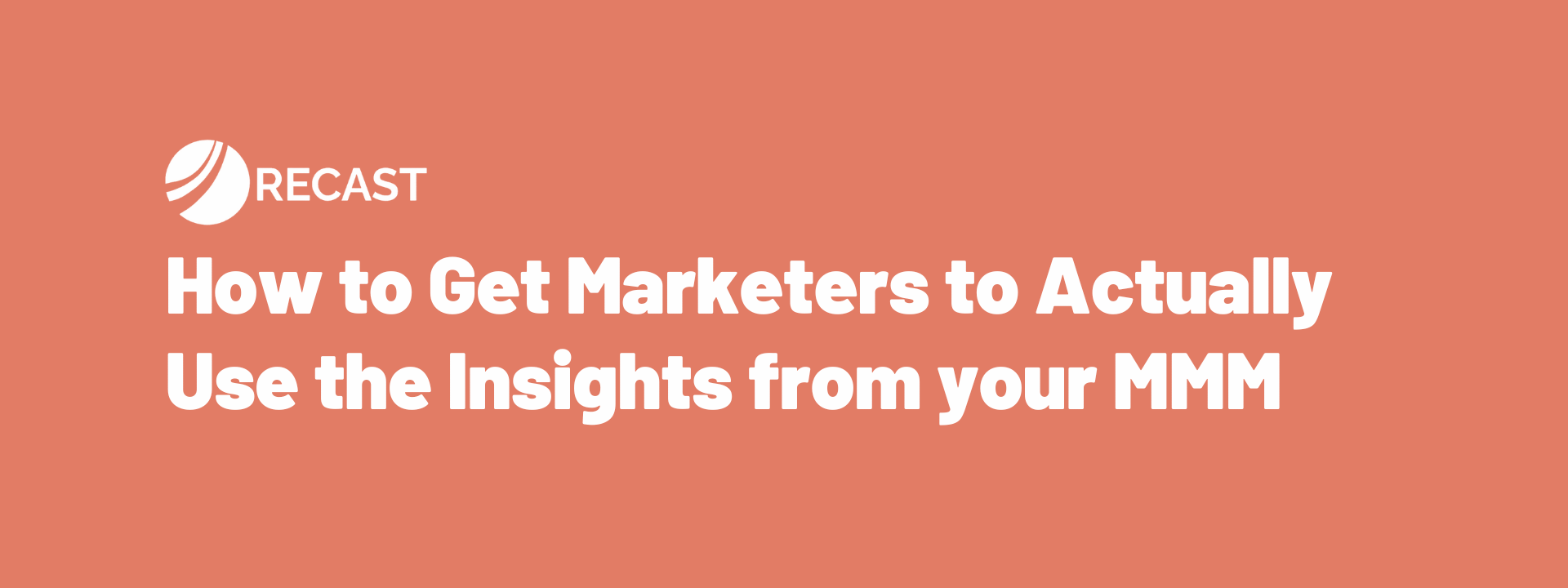One of the biggest challenges in marketing mix modeling that we don’t see get talked about enough is how to get marketers to actually use the results from the MMM. Believe it or not, it’s not uncommon for companies to do MMM, get some valuable insights, and be unable or unwilling to implement the recommended changes.
If you’re getting started in MMM or are in an organization where you have one but you think you’re not getting the most out of it, this article is for you.
Sometimes the root issue is that companies don’t fully understand why they’re doing MMM in the first place. I often see brands realize they are having problems with MTA, and so they go run an MMM in an Excel sheet or hire some fly-by-night consultant who doesn’t really know what they’re doing.
If you’re a brand considering getting started with MMM, you need to make sure you’re ready to commit to using an entirely new measurement system.
It’s not easy to make that change. If your marketing team is not ready to pivot strategies, reallocate budgets, or experiment with new channels based on MMM insights, then just don’t do it at all and save yourself the effort.
Now, if you decide to do it, you need to take it really seriously and be ready to invest in making sure that you have a good model with results that you can trust.
After working with many different companies – the vast, vast majority of organizations using Recast very effectively – we have gathered a few guiding thoughts on what makes the companies that leverage MMM well vs the ones that don’t.
Making the Most of Recast: Put It into Action
The thing that we tell everyone is that the Recast platform works best when you use it. If you just think about it as a place for interesting insights, you’re not going to get that much value out of it.
Recast is going to work best when you actually start to make decisions using the platform. The core reason behind this is that marketing mix modeling needs signal to make reads. No signal, no results.
Signal, in this case, means that we look at the days where your channel mix spend changes and how they’re different, and then we’re going to look at how we acquire different amounts of customers based on different amounts of marketing activity. If we see a big increase in spend on a certain channel and then we don’t see an increase in customers, we’ll know that spend wasn’t very incremental.
And then we’re going to do that lots and lots of times for all of the different marketing channels on all of the days going back into history until we can give you estimates of incrementality across the board so you can make better budget allocation decisions.
If you keep your marketing budgets the same, we’re not creating any value for you because, by definition, we won’t get any signal. We can only create value when you go out and make changes to your budget up or down, you invest in new channels, etc.
Additionally, making those sorts of changes actually makes the Recast platform better. Our platform is adaptive and it’s learning every week based on the data that it sees, so using the model gives the model that additional signal to get better estimates.
In practicality, if you go out and you make a change – scale up Meta spend, for example – Recast will make a forecast as to how much additional revenue it’s expecting to see next based on that change.
If you get more revenue than the model expected, the model will learn that Meta is more incremental than it thought and adapt to what it’s seeing.
For the marketers who have used the legacy MMM partners, where it’s really just about insights, it can be a mindset shift to think about this as an adaptive tool that they can use to make changes going forward.
Embracing a Mindset of Experimentation and Calculated Risk-Taking
Now, we get it, we’re asking you to use the platform to get signal, but what if the changes you make show a channel is not incremental and the test “fails”? Or what if you do a holdout experiment on a channel that is incremental and there’s an opportunity cost you have to pay for?
These are real questions that are a paradigm change in the way most marketers think about marketing. Mindset is probably the biggest hurdle that marketers face when implementing marketing mix modeling. But here’s the thing:
You’re never going to know perfectly what each dollar is going to do for you with 100% confidence. It’s impossible. We’re never going to get there.
But if we look at Recast’s output versus your multi-touch attribution and Recast says, “this channel is outperforming relative to the measurement that you’re getting from this other measurement vendor or method that you’re using” – that’s good evidence that you should go take a bet on that channel.
What we have found is that when our customers place bets where Recast is pushing them, more often than not, that works out well for the business.
It’s not 100% perfect all of the time. If the goal is perfect, we wouldn’t ever be able to do anything. Things change. Creatives don’t perform sometimes. There are lots of reasons things can go wrong.
But in the long run, placing bets in places where you have additional confidence based on good evidence will propel your business forward and can be incredibly valuable.
The goal is to get you better than where you are today, and that we can definitely do. And getting better than where we are today can save many brands millions and millions and millions of dollars.
Building a Foundation for Successful MMM Implementation
Now, if you’ve read the list above and realized that your company might not be ready to implement MMM just yet, that’s fine! For now, focus on building the foundation to change how you think about measurement: start educating your team on why incrementality matters and focus on building your “experimentation muscle.”
After $100k+ / month in paid media budget, it’s a good time to start building that culture with geo-lift and holdout tests, for example.
As testing, data, and incrementality become part of your company’s DNA, the transition to MMM will feel like a natural progression rather than a disruptive shift.
And if you’re ready to get started with MMM or if you’re not satisfied with what your current MMM is delivering, we’d love to chat and see if we can help.



